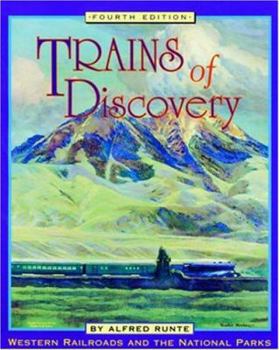Trains of Discovery: Western Railroads and the National Parks
Select Format
Select Condition 
Book Overview
This updated look at railroads and the national parks includes practical information about touring parks by train, offering an alternate solution to the growing traffic congestion in the parks. This description may be from another edition of this product.
Format:Paperback
Language:English
ISBN:1570982317
ISBN13:9781570982316
Release Date:July 1998
Publisher:Roberts Rinehart Publishers
Length:106 Pages
Weight:0.95 lbs.
Dimensions:0.4" x 8.1" x 10.0"
Customer Reviews
2 ratings
The period advertisement reproductions are excellent
Published by Thriftbooks.com User , 19 years ago
In the era when railroads were the primary method of arriving to a national park, railroad companies encouraged the designation of national parks and were the allies of preservationists, though their motives were not altruistic. The railroads sought more passengers and in turn, more profit. National parks proved the ticket to achieve their aims. Though not driven by preservationist aims, railroads had a hand in raising ecological awareness among their passengers and even magazine readers, with striking, sometimes full-color advertisements in periodicals nationwide. In Trains of Discovery: Western Railroads and the National Parks Alfred Runte looks not only at history, but shows the price the nation has paid, both socially and environmentally, for its love affair with the automobile. Runte details the crucial role railroads played in the establishment, protection and improvement of national parks. The Northern Pacific was at the forefront of efforts to designate Yellowstone a national park. Other rail lines played similar roles, such as the Great Northern's vociferous campaign to designate Glacier National Park. Railroads unwaveringly supported the National Park Service legislation, looking forward to working with one government agency committed to promoting national parks (49). Stephen Mather, the first director of the Park Service, teamed with railroads to promote the national parks. The railroads rarely portrayed environmental consciousness in their guidebooks, but dependence on unspoiled scenery to sell national parks as a destination restrained more extractive aims, such as logging and mining (24). Railroad support of Yellowstone as a breeding ground for big game heightened awareness that the West was a refuge for wildlife (29). In the 1960s, rail transportation to national parks and the NPS alliance with the railroads dimmed. As early as 1916, automobile passengers exceeded train passengers in Yosemite National Park (66). Opponents of the Yosemite Valley Railroad were misguided into thinking the line would have a negative impact on the valley. By 1945 the Yosemite Valley Railroad ceased operations and the NPS was given no choice but to accommodate more automobiles to please the surmounting hoard of tourists. At first, preservationists sided with auto accommodation, thinking it would be better than alternatives such as reservoirs and power lines. It is clear the automobile has degraded the environment more than any rail line ever could. The National Parks have intensely suffered from Americans' desire for greater independence behind the wheels of their cars. Runte advocates public transportation as the only way to serve both access and preservation (7). He details how the shuttle service instituted in Yosemite in 1970 became popular once tourists realized the convenience and lack of auto congestion. The mandatory shuttle service in Zion National Park has seen similar positive reception. Though the narrative is engaging and informative, R
An imaginative look at passenger trains and National Parks
Published by Thriftbooks.com User , 26 years ago
Trains of Discovery does well what few books seem to do today -- it looks into the texture of American's past for hidden lessons important for our future. The author has done a masterful job educating readers about how and why America's railroads contributed to the development of the National Park system, a unique story about an industry electing to connect itself with America's spectacular natural landscapes. It examines the railroads' commercial objectives, their sponsorship of unique artwork that captured the spirit of the age, the mobility and development issues at the time, and how all of this affected our national cultural identity. This book, with its clear writing and rich illustrations, also makes learning about all this fun. The author looks to the future and passionately and effectively conveys the need to restore passenger rail service to natural areas as an alternative to auto congestion and pollution. He concludes, "Trains and the national parks just naturally go together." He has me convinced, and as an author and public speaker I've found myself quoting Mr. Runte's book many times.





